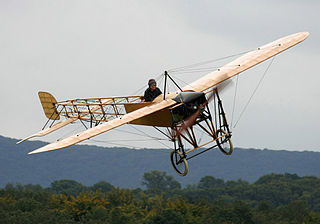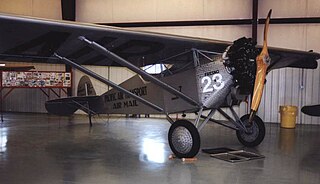
The Gee Bee Model R Super Sportster was a special-purpose racing aircraft made by Granville Brothers Aircraft of Springfield, Massachusetts at the now-abandoned Springfield Airport (Massachusetts). Gee Bee stands for Granville Brothers.

Planes of Fame Air Museum is an aviation museum in Chino, California, and Valle, Arizona. The museum has many flying and static aircraft, along with several rare examples under restoration.

Fantasy of Flight is an aviation museum in Polk City, Florida.
The 1911 Curtiss Model D was an early United States pusher aircraft with the engine and propeller behind the pilot's seat. It was among the first aircraft in the world to be built in any quantity, during an era of trial-and-error development and equally important parallel technical development in internal combustion engine technologies.

The Blériot XI is a French aircraft of the pioneer era of aviation. The first example was used by Louis Blériot to make the first flight across the English Channel in a heavier-than-air aircraft, on 25 July 1909. This is one of the most famous accomplishments of the pioneer era of aviation, and not only won Blériot a lasting place in history but also assured the future of his aircraft manufacturing business. The event caused a major reappraisal of the importance of aviation; the English newspaper The Daily Express led its story of the flight with the headline "Britain is no longer an Island".

The Aeronca L was a 1930s American cabin monoplane designed and built, in small numbers, by Aeronca Aircraft. It differed significantly from other Aeronca planes by the use of radial engines, streamlining, and a cantilever low wing.

The Gee Bee Sportster was a family of sports aircraft built in the United States in the early 1930s by the Granville Brothers. They were low-wing strut- and wire-braced monoplanes of conventional, if short-coupled, design, with open cockpits and fixed, tailskid undercarriage.

The Gee Bee Model Y Senior Sportster was a sport aircraft built in the United States in the early 1930s by the Granville Brothers. Essentially an enlarged two-seat version of the single-seat Sportster, it was a low-wing strut-and-wire-braced monoplane of conventional design with open cockpits and fixed tailskid undercarriage. The first of the two examples constructed remained with the Granville Brothers company and competed in many races, piloted by Maude Tait and Russell Boardman, among others. Later it also served as a support aircraft for the R-1 and R-2 racers. The second Model Y was built to order for the Cord Auto Company to be used as an engine testbed for the Lycoming R-680 engine they produced. This aircraft was later refitted with a Wright Whirlwind of nearly double the power of its original powerplant. In this form, it was flown by Florence Klingensmith at the 1933 Chicago International Races, where she won second place in the Women's Free-For-All, then perished in the aircraft after fabric became detached from the upper right wing while contesting the Phillips Trophy.
Lowell Richard Bayles was an air race pilot from the "Golden Age of Air Racing." He was the winner of the 1931 Thompson Trophy flying the Gee Bee Model Z. He was killed during an attempt at the landplane speed record when the Model Z he was flying crashed at over 300 miles per hour (483 km/h) mph.

The Ryan M-1 was a mail plane produced in the United States in the 1920s, the first original design built by Ryan. It was a conventional gear parasol-wing monoplane with two open cockpits in tandem and fixed, tailskid undercarriage.

The Granville Gee Bee Model Z was an American racing aircraft of the 1930s, the first of the Super Sportster aircraft built by Granville Brothers Aircraft of Springfield, Massachusetts, with the sole intent of winning the Thompson Trophy, which it did in 1931. However, it soon suffered a fatal crash during a world speed record attempt, starting the reputation of the Gee Bee aircraft as killers.
Robert L. Hall (1906–1991) was an American Air racing pilot and aircraft designer.

The sole Granville Gee Bee R-6 International Super Sportster, named "Q.E.D." Quod Erat Demonstrandum, and later named "Conquistador del Cielo", was the last in a series of racing and touring monoplane aircraft from the Granville Brothers. The R-6H was dogged with bad luck throughout its career and had the distinction of never finishing any race it entered.

The Hawks Miller HM-1, named Time Flies was an American racing aircraft that was the joint project of pilot-owner, Frank Hawks and Howell W. "Pete" Miller, chief engineer for the Granville Brothers. Although very advanced for its time with an enclosed cockpit that highlighted its streamlined lines, development ended after a crash during testing. A completely new design emerged when the aircraft was re-configured as a two-seat military aircraft.

The Military Aircraft HM-1, derived from the earlier Hawks Miller HM-1 racing aircraft nicknamed, "Time Flies" was an American prototype attack/observation aircraft. The HM-1 did not achieve production after the sole example was destroyed during testing.

The Stinson Model O was an American single-engined military trainer aircraft of the 1930s designed built by the Stinson Aircraft Company. Based on the Stinson SR, the Model O was designed to meet a requirement of the Honduran Air Force, forming the initial equipment of that air arm.
The C-8 Eightster was a single-engine airliner developed by Granville Brothers Aircraft that did not go into production.

The Gee Bee Model A was an American two-seat open cockpit single-bay biplane developed by the Granville Brothers that first flew in 1929.

















